| Aug 18, 2022 |
Considering how friction is maximised when liquids flow on nanoscales
(Nanowerk News) The dynamics of how liquids behave when confined in a nanoscale-sized space such as nanochannels, nanotubes or nanopores, is key to understanding a wealth of processes including lubrication, filtration and even energy storage.
|
|
The dynamics of liquids at nanoscales are different to behaviour in confinement at macroscales, however. One of the key differences that a reduction in scale creates is friction and shear between the liquid and its solid container. And further complications arise in systems with solid-to-solid contact with features like wear, micro-pitting and scuffing created.
|
|
A new paper published in EPJ E ("Maximizing Friction by Liquid Flow Clogging in Confinement") and authored by Shan Chen, from the State Key Laboratory of Organic-Inorganic Composites at Beijing University of Chemical Technology, China, uses simulations of molecular dynamics to look at the friction-induced nano-confined liquids.
|
 |
| A cross-section of simulations of several different flow types with pistons placed at different positions. (Image: S. Chen et al, 2022)
|
|
The simulation was created using the Molecular Massively Parallel Simulator (LAMMPS) which facilitated the investigation of how the properties of a confined liquid cooperatively affect the friction force between a liquid column and confining solid substrates. The authors considered three different flow types and assessed how these changed with fluid velocity.
|
|
The team simulated flows of Lennard-Jones (LJ) chain-like liquid encaged in a solid cylindrical nanopore with atomically smooth surfaces. To replicate the effect of solid/solid contact on liquid/solid friction, the authors introduce model geometries through pistons.
|
|
One of these pistons was placed on the left side of the confined liquid, and provided a driving force pushing the fluid column, while the piston on the right side was freely movable.
|
|
The resultant simulation reveals the existence of a variable previously not considered — molecular clogging — on liquid/solid friction. This arises in the strongly confined liquid, the researchers say, from the aforementioned solid to solid contact.
|
|
This results in a modified flow sharing features of plug and Poiseuille flow — the flow of liquid between two infinitely long parallel plates — that is different at the nanoscale than the standard Poiseuille flow observed at the macroscale.
|

